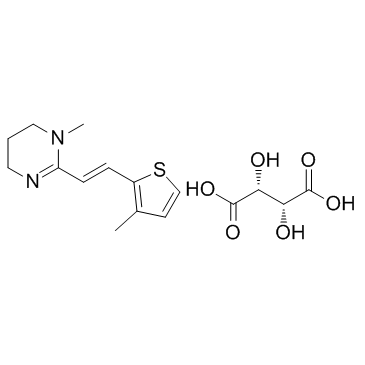Morantel tartrate

(Synonyms: 酒石酸甲噻嘧啶) 目录号 : GC32285
A positive allosteric modulator of nAChRs

Cas No.:26155-31-7
Sample solution is provided at 25 µL, 10mM.
Morantel is a positive allosteric modulator of neuronal nicotinic acetylcholine receptors (nAChRs).1 It enhances channel gating of the α3β2 nAChR subtype by binding to non-canonical sites.2 Formulations containing morantel are used to treat nematode infections in livestock.3
1.Wu, T.Y., Smith, C.M., Sine, S.M., et al.Morantel allosterically enhances channel gating of neuronal nicotinic acetylcholine alpha 3 beta 2 receptorsMol. Pharmacol.74(2)466-475(2008) 2.Seo, S., Henry, J.T., Lewis, A.H., et al.The positive allosteric modulator morantel binds at noncanonical subunit interfaces of neuronal nicotinic acetylcholine receptorsJ. Neurosci.29(27)8734-8742(2009) 3.McKellar, Q.A., Scott, E.W., Baxter, P., et al.Pharmacodynamics, pharmacokinetics and faecal persistence of morantel in cattle and goatsJ. Vet. Pharmacol. Ther.16(1)87-92(1993)
| Cas No. | 26155-31-7 | SDF | |
| 别名 | 酒石酸甲噻嘧啶 | ||
| Canonical SMILES | CC1=C(/C=C/C2=NCCCN2C)SC=C1.O=C(O)[C@H](O)[C@@H](O)C(O)=O | ||
| 分子式 | C16H22N2O6S | 分子量 | 370.42 |
| 溶解度 | DMSO: 125 mg/mL (337.45 mM) | 储存条件 | Store at -20°C |
| General tips | 请根据产品在不同溶剂中的溶解度选择合适的溶剂配制储备液;一旦配成溶液,请分装保存,避免反复冻融造成的产品失效。 储备液的保存方式和期限:-80°C 储存时,请在 6 个月内使用,-20°C 储存时,请在 1 个月内使用。 为了提高溶解度,请将管子加热至37℃,然后在超声波浴中震荡一段时间。 |
||
| Shipping Condition | 评估样品解决方案:配备蓝冰进行发货。所有其他可用尺寸:配备RT,或根据请求配备蓝冰。 | ||
| 制备储备液 | |||
 |
1 mg | 5 mg | 10 mg |
| 1 mM | 2.6996 mL | 13.4982 mL | 26.9964 mL |
| 5 mM | 0.5399 mL | 2.6996 mL | 5.3993 mL |
| 10 mM | 0.27 mL | 1.3498 mL | 2.6996 mL |
| 第一步:请输入基本实验信息(考虑到实验过程中的损耗,建议多配一只动物的药量) | ||||||||||
| 给药剂量 | mg/kg |  |
动物平均体重 | g |  |
每只动物给药体积 | ul |  |
动物数量 | 只 |
| 第二步:请输入动物体内配方组成(配方适用于不溶于水的药物;不同批次药物配方比例不同,请联系GLPBIO为您提供正确的澄清溶液配方) | ||||||||||
| % DMSO % % Tween 80 % saline | ||||||||||
| 计算重置 | ||||||||||
计算结果:
工作液浓度: mg/ml;
DMSO母液配制方法: mg 药物溶于 μL DMSO溶液(母液浓度 mg/mL,
体内配方配制方法:取 μL DMSO母液,加入 μL PEG300,混匀澄清后加入μL Tween 80,混匀澄清后加入 μL saline,混匀澄清。
1. 首先保证母液是澄清的;
2.
一定要按照顺序依次将溶剂加入,进行下一步操作之前必须保证上一步操作得到的是澄清的溶液,可采用涡旋、超声或水浴加热等物理方法助溶。
3. 以上所有助溶剂都可在 GlpBio 网站选购。
Quality Control & SDS
- View current batch:
- Purity: >98.00%
- COA (Certificate Of Analysis)
- SDS (Safety Data Sheet)
- Datasheet





















